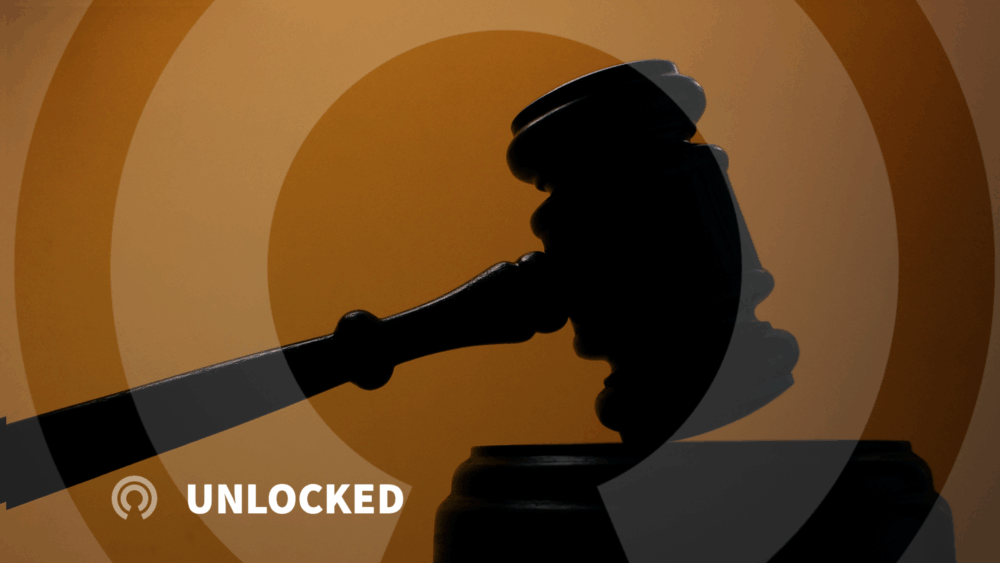
Explainers, Podcasts, Videos
Unlocked: How do class action lawsuits work?
Reports & Papers
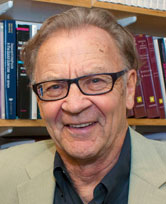
A new report from Harvard Kennedy School’s Shorenstein Center on Media, Politics and Public Policy analyzes news coverage of the 2016 Republican and Democratic national conventions, and whether this coverage, which was overwhelmingly negative, best served the needs of the public.
This report is the third in a multi-part series of research analyzing news coverage of candidates and issues during the 2016 presidential election. The study examines news coverage during the four-week convention period, starting with the week prior to the Republican convention and concluding with the week following the Democratic convention.
The daily news audience is larger than that of the convention viewing audience, meaning that many people learn about the conventions through the news media’s version of the events. Coverage of Donald Trump continued to outpace that of Hillary Clinton during this period, but, notably, both candidates received negative coverage.
Negative news reports about policy positions, for example, outnumbered positive reports 82 percent to 18 percent. Trump experienced a reversal of the “good press” he had received earlier in the campaign, with his reaction to the Democratic convention speech of Khizr Khan generating the most negative attention. Although Clinton’s coverage was more positive than Trump’s, it was still negative on balance, with a full tenth of her coverage revolving around allegations of wrongdoing.
What appeared to be missing from this negative coverage, however, was context. For example, although Clinton’s email issue was clearly deemed important by the media, relatively few stories provided background to help news consumers make sense of the issue—what harm was caused by her actions, or how common these actions are among elected officials. And in keeping with patterns noted earlier in the election cycle, coverage of policy and issues, although they were in the forefront at the conventions, continued to take a back seat to polls, projections, and scandal.
This Shorenstein Center study is based on an analysis of news reports by ABC, CBS, CNN, Fox, the Los Angeles Times, NBC, The New York Times, USA Today, The Wall Street Journal, The Washington Post, and The Washington Times. The study’s data were provided by Media Tenor, a firm that specializes in the content analysis of news coverage. The research was partially funded by the John S. and James L. Knight Foundation.
Read the newest report in the series: News Coverage of the 2016 General Election: How the Press Failed the Voters.
Live television coverage of the national party conventions gives the nominees the opportunity to present themselves unmediated and at length to the American people. There’s no moment in the presidential campaign when the candidates so fully control the message as during the party conventions.
Yet the live coverage is not the only version of the party conventions. Americans are also exposed to a secondhand rendition, one that is highly mediated. It’s the news media’s version of the convention, where the prevailing voices are not those of the nominees but instead those of reporters. Figure 1 shows just how true that was of the 2016 convention period. On television and in the newspapers, journalists were the voice behind roughly seven out of every ten news reports about the candidates. The nominees were heard speaking for themselves in less than one in ten reports.
Figure 1: Source of News Reports
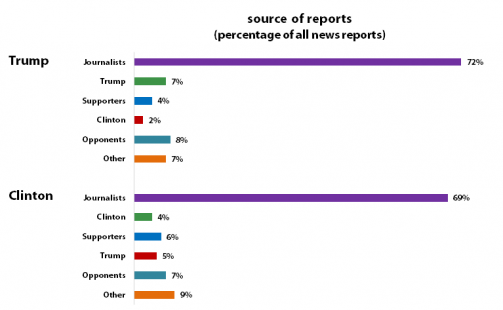
Donald Trump spoke directly more often in the news than did Hillary Clinton but, even so, his voice accounted for only 7 percent of his coverage. Clinton’s voice accounted for a meager 4 percent of her coverage. In fact, Trump had a larger voice than Clinton in her coverage, supplying 6 percent of the news reports about her. She was heard directly in only 2 percent of Trump’s coverage—a mere one in every fifty reports.
Nevertheless, the large point here is that journalists do most of the talking, a tendency that is now several decades old. In the 1960s, journalists began shifting from their traditional descriptive style of reporting— “who, what, when, and where”—to a more interpretive style that included the “why.”[1] It served to shift control of the news to reporters. Newsmakers had the upper hand with the older form. The journalist’s task was to describe events, which typically meant telling the audience what newsmakers had said and done.[2] The newer interpretive form altered that formula. Newsmakers’ actions would still make the news and even provide many of the headlines and story leads, but the message would be shaped by the interpretation the journalist imposed on events.[3] Instead of simply reporting events, the raw material would be repackaged with the journalist, not the newsmaker, at the center.[4]
Each new poll or disruption gives journalists the opportunity to reassess the candidates’ tactics and positions in the race. Policy issues, on the other hand, lack novelty. A new development may thrust a new issue into the campaign, but policy problems are typically longstanding.
The change did not take place all at once. Vestiges of the older form remained but the shift was unmistakable. In the 1960s, when the older descriptive style prevailed, the average candidate sound bite on the evening news exceeded 40 seconds and the average continuous quote or paraphrase of a candidate’s words in the newspaper was roughly 20 lines. By the late 1980s, the average sound bite had shrunk to 10 seconds—only long enough for a sentence or two—and the average newspaper quote or paraphrase had been cut by two-thirds.[5]
As the candidates’ voices became quieter and journalists’ voices became louder, the content of election news shifted. Presidential candidates spend their time talking about their issues and qualifications, hoping that voters will find the pitch appealing enough to carry them to victory.[6] Reporters see the campaign differently. They are on the lookout for compelling stories. That perspective leads them to favor what’s timely over what’s old, what’s novel over what’s predictable, what’s sensational over what’s drab, what’s negative over what’s positive.
The shift to journalist-centered news has been consequential. One effect has been to elevate the horse race at the expense of the election’s substance. [7] No aspect of the campaign meets journalists’ need for novelty more predictably than does the horse race. Each new poll or disruption gives journalists the opportunity to reassess the candidates’ tactics and positions in the race. Policy issues, on the other hand, lack novelty. A new development may thrust a new issue into the campaign, but policy problems are typically longstanding. If they came and went overnight, they would not be problems. [8] Thus it is that when a candidate first announces a policy stand, it makes news. Later on, it normally doesn’t.
These tendencies were evident in news coverage of the 2016 convention period, as Figure 2 indicates. Even though the horse race was not as large a part of news reporting during the convention period as it was during the primaries, it easily outpaced reports about the candidates’ issues or qualifications. Polls, projections, and the like constituted about a fifth of all coverage, whereas issues took up less than a tenth and the candidates’ qualifications for the presidency accounted for less than a twentieth.
Figure 2: Topics of Convention News Coverage
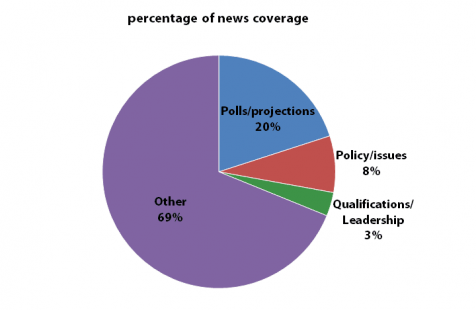
A second consequence of the shift to journalist-centered news has been to elevate the negative at the expense of the positive. Although Donald Trump might well be an exception, candidates spend most of their time talking up their issues and why they are qualified to be president. They also attack their opponents’ positions and fitness for office, but it’s the secondary thrust of most of their speeches.[9] Journalists, on the other hand, have a preference for the attack.[10] Conflict makes for better stories than does cooperation or agreement.
Figure 3 shows the degree to which the negative outpaced the positive during the 2016 convention period. For the full period, negative news reports outstripped positive ones by nearly two to one. There was not a single week where positive reports about the candidates came close to matching negative ones, much less outnumbering them.
Figure 3: Tone of Convention News Coverage
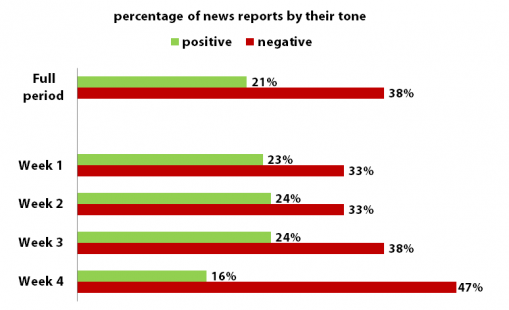
The rest of this report will probe more deeply into news reporting during the convention period, focusing on the candidates’ coverage and how news values intersected with campaign developments to shape the news media’s version.
This study is the third in our series of reports on media coverage of the 2016 presidential election. The first examined news coverage during 2015—the so-called “invisible primary” stage of the campaign. The second study focused on news coverage of the presidential primaries and caucuses.
This third study examines news coverage during the four-week convention period, starting with the week prior to the Republican convention and concluding with the week following the Democratic convention. Each week’s coverage was tallied from Monday through the following Sunday. The coverage is confined to the print editions of six daily newspapers and five television networks. In the case of the newspapers—the Los Angeles Times, The New York Times, The Wall Street Journal, The Washington Post, The Washington Times, and USA Today—the analysis covers all sections except sports, obituaries, and letters to the editor. Op-eds and editorials are included, but letters from the public are not. For television, the analysis covers the full daily content of each network’s main newscast—ABC World News Tonight, CBS Evening News, CNN’s The Situation Room, Fox’s Special Report, and NBC Nightly News.
The data for our studies are provided by Media Tenor, a firm that specializes in collecting and coding news content. Media Tenor’s coding of print and television news stories is conducted by trained full-time staff members who visually evaluate the content. Coding of individual actors (e.g., presidential candidates) is done on a comprehensive basis, capturing all reports of more than five lines (print) or five seconds (TV) of coverage for a given actor. During the convention period, more than 7,000 news reports met the length requirement and were coded. For each report, coders identified relevant themes (topics) and actors and evaluated the tone (positive or negative) on a six-point scale. These tonality ratings were then combined to classify each report for each actor as being negative, positive, or having no clear tone.
During the month-long convention period, Trump was the main attraction (see Figure 4). He received a third more coverage than Clinton, drawing 27 percent of the campaign coverage to her 20 percent. There was only one week, that of the Democratic convention, when Clinton received more news attention and then by the narrow margin of 2 percentage points. Trump’s coverage outpaced Clinton’s by at least 7 percentage points in each of the other three weeks.
Figure 4: Amount of News Coverage Received by Presidential Nominees
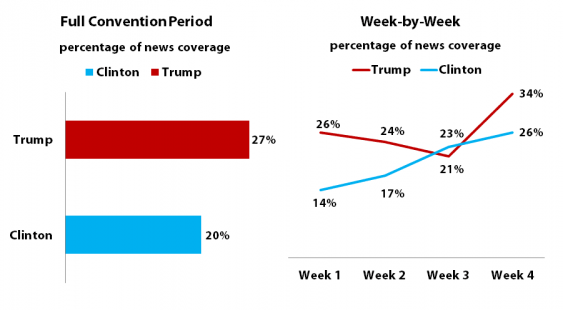
Why was Trump’s candidacy so much more newsworthy? Developments on the floor of the national conventions would not have predicted it. Speaker after speaker at the Republican convention tore into Clinton. Meanwhile, speaker after speaker at the Democratic convention spoke her praises. Nevertheless, when it came to convention news coverage, she played second fiddle to Trump.
Unlike Trump, Clinton is a conventional candidate….she is not in most respects a steady source of fresh or remarkable stories.
Trump’s newsworthiness stems from journalists’ sense of what’s news, and what’s not. Although journalists play a political brokering role in presidential campaigns, their decisions are driven by news values rather than political values. Journalists are drawn to story material that can catch and hold an audience’s attention. Trump meets that need as no other presidential nominee in memory. Trump’s politics of outrage and attack fits squarely with journalists’ story needs.
In our two previous reports, we showed just how fully Trump has dominated coverage of the 2016 presidential election. In 2015, Trump received 50 percent more news coverage than his nearest Republican rival.[11] During the contested phase of the Republican primaries, Trump’s press edge over his nearest rival exceeded 50 percent. Even after his Republican rivals quit the race, Trump was the most heavily covered candidate. Although Clinton and Bernie Sanders carried their battle all the way to the last primary, Trump received the most news attention during the final month of the primaries.
Unlike Trump, Clinton is a conventional candidate. She’s not much more or less likely than other recent nominees to go on the attack or take a shocking stand on an issue. She is newsworthy largely for the simple fact that she is, after all, her party’s presidential nominee. But, unlike Trump, she is not in most respects a steady source of fresh or remarkable stories.
The convention period was not a press-friendly time for Trump—his “bad press” outpaced his “good press” by a three-to-one margin.
In terms of news topics, Trump’s coverage differed somewhat from what’s been typical of recent nominees.[12] For sure, he got the normal dose of horse race coverage for a convention period. Polls and projections of his chances of winning accounted for nearly a fifth of his coverage.[13]However, his issue and policy positions got more attention than is usually the case, accounting for a full eighth of his coverage (see Figure 6). His personal character and life also drew an unusual amount of news attention. They accounted for 8 percent of his coverage, an amount that’s higher than normal.
Figure 5: Trump’s News Coverage, by Topic
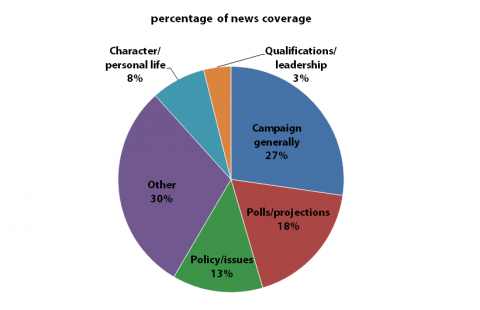
Trump might have wished that the press had paid him less attention. As Figure 6 reveals, the convention period was not a press-friendly time for Trump—his “bad press” outpaced his “good press” by a three-to-one margin. That was a reversal of the coverage Trump had enjoyed earlier in the campaign. During 2015 and the early phases of the primaries, Trump had received mostly positive coverage. It began to turn negative after his Republican rivals dropped from the race, and the convention period continued the downward spiral.
Figure 6: Tone of Trump’s News Coverage
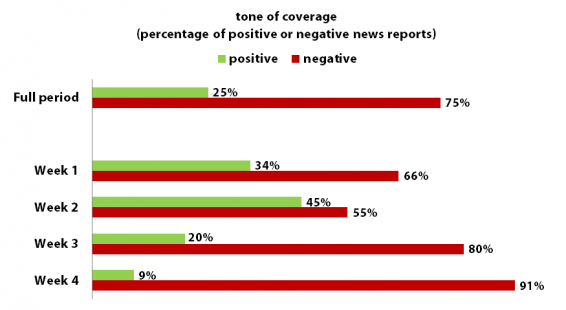
Trump’s coverage was in negative territory during all four weeks. His best week was that of the Republican convention, when his negative press outpaced his positive press by only five-to-four. His coverage went sharply downhill from there, dropping to a three-to-one negative over positive ratio during the week of the Democratic convention to a ten-to-one ratio during the week that followed. Those two weeks marked Trump’s worst coverage to that point in the campaign. From the time he announced his candidacy until the start of the conventions, Trump had not experienced anywhere near the press criticism directed at him during the final two weeks of the convention period.
There was no safe haven for Trump. His convention-period coverage was negative in all the news outlets in our study, even those that normally side with the Republican nominee (see Figure 6). The Washington Times gave Trump his best coverage, but it was three-to-two negative over positive. On Fox, his coverage ran two-to-one negative over positive. The Wall Street Journal was the most critical of the eleven news outlets, with a seven-to-one ratio of negative to positive. Trump’s negative balance among the other outlets ranged from three-to-two negative on ABC World News Tonight, to nearly seven-to-one negative on the NBC Nightly News.
Figure 7: Tone of Trump’s Coverage, by News Outlet
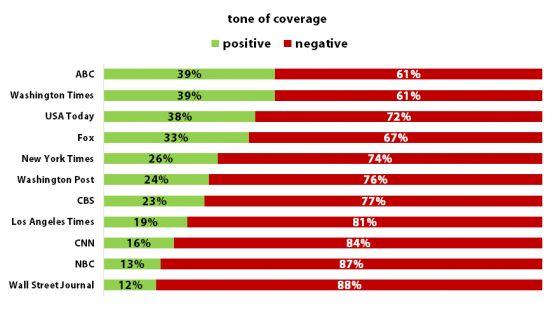
Trump’s negative coverage touched virtually every aspect of his campaign, including the component—the horserace—that had sustained his positive press earlier in the campaign. During that phase, as Trump rose in the polls and then won key primaries, he got favorable press. It was a story of growing momentum, rising poll numbers, ever larger crowds, and electoral success. The fact that the horse race is the most heavily covered aspect of the nominating phase magnified the good news. The media’s fixation on the horse race was producing positive press for him, and lots of it.
There was a brief moment during the nominating period when it appeared that the press’s horse race fixation would once again work to Trump’s advantage. Polls conducted shortly after the Republican convention showed him pulling ahead of Clinton. In the ensuing week (July 25-July 31), Trump’s horse race coverage was positive on balance. But that burst of good news was swamped during the other three weeks by poll-driven news reports. The final week of the convention period, when polls showed Clinton pulling away from Trump, was easily his worst—eighteen-to-one negative over positive. Said The Wall Street Journal in one of its reports: “A new batch of polls in key swing states show Donald Trump falling further behind Hillary Clinton, as a series of missteps and turmoil within the GOP harm the Republican nominee’s campaign . . . . Mr. Trump’s poor standing could cost him . . . the presidency.”[14]
At that, Trump’s horse race coverage was one of his brighter spots. Whereas his horse race coverage was two-to-one negative for the convention period, news reports about his issue and policy stands were seven-to-one negative (see Figure 8). Every one of his top issues, including immigration and trade, was a source of criticism. The critics included otherwise sympathetic voices. NBC News quoted a Republican convention delegate as saying, “I’m not convinced . . . that the ‘Wall’ is a panacea for illegal immigration.”[15]
Figure 8: Tone of Trump’s News Coverage, Selected Topics
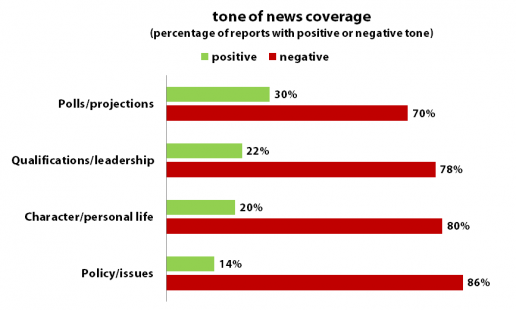
By a margin of four-to-one, Trump’s character and personal life also contributed to his negative coverage. His family members, several of whom spoke at the Republican convention, were a source of good news but they accounted for only about 1 percent of Trump’s convention-period coverage. Other references to his personality or private life accounted for 7 percent of his coverage and were a uniform source of bad press. Wrote a Washington Post columnist, “One wonders if Republican leaders have begun to realize that they may have hitched their fate and the fate of their party to a man with a disordered personality.”[16]
Trump fared no better when it came to the question of his leadership ability and qualifications, save for the fact that they received less than half as much attention as his personal qualities. Much of the coverage here revolved around the issue of whether Trump had a grasp of major policy issues. Shortly before the start of the Republican convention, Trump said that, as president, he would assist a NATO ally under attack only if it had met its obligations to the United States, apparently unaware that the NATO treaty requires alliance members to assist an invaded member. CBS News quoted Republican Mitch McConnell, the Senate majority leader, as saying, “I disagree with that. NATO is the most important military alliance in world history. I want to reassure our NATO allies that if any of them get attacked, we’ll be there to defend them.”[17]
No development brought Trump more undesirable news attention than his reaction to the Democratic convention speech of Khizr Khan…
No development brought Trump more undesirable news attention than his reaction to the Democratic convention speech of Khizr Khan, a Pakistani American whose son, Army Captain Humayun Khan, was killed in 2004 during the Iraq War. Responding to Trump’s claims that he would sharply curtail Muslim immigration, the Khans addressed their convention speech to Trump, saying: “Have you ever been to Arlington Cemetery? Go look at the graves of brave patriots who died defending the United States of America. You will see all faiths, genders, and ethnicities. You have sacrificed nothing—and no one.” In a subsequent interview on ABC, Trump took on Khan’s wife, who stood beside her husband during his convention speech. Said Trump: “If you look at his wife, she was standing there. She had nothing to say. She probably—maybe she wasn’t allowed to have anything to say. You tell me.”[18]
The ensuing firestorm brought Trump a slew of coverage during the final week of the convention period. The reporting was nearly 100 percent negative, and cut across nearly every area of Trump’s coverage: his stand on immigration, his personal character, his knowledge of the law, his poll standing. The Khan exchange was that week’s most heavily covered development, shifting the balance of news attention strongly in his direction. He got 34 percent of that week’s campaign coverage—the highest weekly total of any presidential candidate at any point to date in the 2016 campaign. And the overall tone of his coverage was 91 percent negative—the most negative for any candidate in any single campaign week to date.
Clinton’s coverage differed markedly from Trump’s. As noted previously, she received significantly less news attention than Trump during the convention period. The mix of her coverage also differed from his (see Figure 9). Horse race topics—polls and projections—were a somewhat larger part of her coverage while the substance of her campaign got significantly less coverage. Her policy and issue positions received only a third of the coverage afforded Trump’s—a mere 4 percent versus his 13 percent.
Figure 9: Clinton’s News Coverage, by Topic
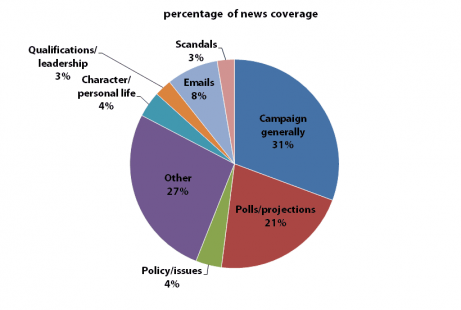
A major difference between Trump and Clinton’s coverage was that she had a news category entirely of her own—the emails that she sent and received as secretary of state. Clinton’s emails accounted for 8 percent of her news coverage during the conventions—twice the amount of all of her policy positions combined. Alleged scandals from Clinton’s past accounted for an additional 3 percent of her coverage. A full tenth of Clinton’s coverage, in one form or another, revolved around allegations of wrongdoing.
Clinton’s emails accounted for 8 percent of her news coverage during the conventions—twice the amount of all of her policy positions combined.
The tone of Clinton’s coverage was more positive than Trump’s. Nonetheless, it was negative on balance (see Figure 10). Negative news reports about Clinton during the convention period outpaced positive ones by 56 percent to 44 percent, continuing the pattern of her coverage earlier in the campaign. During the year-and-a-half long period leading up to the conventions, Clinton’s coverage was more than two to one negative over positive—the worst of any presidential contender. The negative trend continued into the first two weeks of the convention period, which included the week of the Republican convention. Only during the last two weeks did the tone of her coverage shift and, even then, she received roughly as much negative press as positive press.
Figure 10: Tone of Clinton’s News Coverage
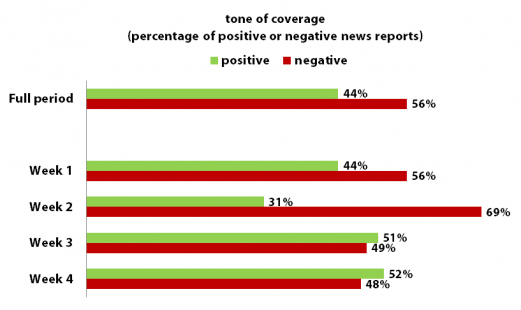
However, Clinton did get positive press in some news outlets (see Figure 11). ABC, CNN, the Los Angeles Times, and The Wall Street Journal gave her more good press than bad press by a margin of anywhere from 10 percentage points to 21 points. Coverage on CBS and in The Washington Post divided almost evenly between positive and negative reports. For their part, USA Today, The New York Times, NBC, and Fox gave her mostly negative coverage, with the range varying from 10 to 20 percentage points. The conservative-leaning Washington Times was a clear outlier—on its pages, Clinton’s negative coverage outstripped her positive coverage by 62 percentage points.
Figure 11: Tone of Clinton’s Coverage, by News Outlet
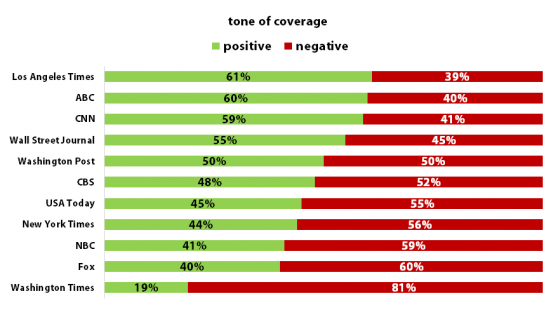
In terms of tone, Clinton’s presidential qualifications were the source of her most positive press (see Figure 12). Reporting on this topic was two-to-one positive. However, her qualifications accounted for only 3 percent of her total coverage—too little to significantly affect the overall tone of her coverage.
The largest contributor to Clinton’s positive press was the horse race coverage, which accounted for a fifth of her total coverage and was five-to-four favorable. She was leading in the polls when the convention period began and carried that lead through the week of the Republican convention. The bounce in the polls that Trump got from his party’s convention thrust him momentarily into the lead, which temporarily turned her horse race coverage in a negative direction. But Clinton’s bounce from the Democratic convention in the third week put her back into the lead, which widened further when Trump got embroiled in the Kahn controversy. The fourth week was easily Clinton’s best in terms of her horse race coverage—the ratio of positive to negative press on that topic was nine-to-one. In a story titled “Clinton Jumps to Big Lead over Trump in New National Polls,” USA Today wrote that “Hillary Clinton had a 15-point lead over Donald Trump in a national poll out Thursday following the Republican nominee’s insults of the parents of a fallen soldier and otherwise rocky week in his campaign….Clinton made gains with every ethnic and racial group, including whites and men, which Trump had led with previously.”[19]
Figure 12: Tone of Clinton’s News Coverage, Selected Topics
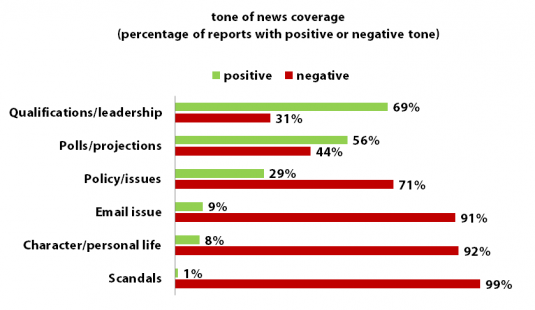
Clinton’s horse race coverage was the only truly bright spot in her coverage during the convention period. News reporting on her policy issues was more than two-to-one negative, and it was eleven-to-one negative for reports relating to her personal life and character. Most of the criticism came in the form of partisan attacks. “Donald Trump accused Democratic rival Hillary Clinton of a legacy of ‘death, destruction, terrorism and weakness’ as U.S. secretary of state,” said one story. [20]
No topic, however, tilted Clinton’s coverage more toward the negative than did allegations surrounding her use of emails as secretary of state. The email issue accounted for 8 percent of her coverage, and negative reports outpaced positive reports by ten-to-one. Earlier “scandals” also contributed to the negative balance in her overall coverage. Those allegations made up 3 percent of her news reports, with 99 percent of them being negative in tone. Many of the stories of Clinton’s emails were rooted in polls showing that they were undermining her candidacy. CBS said in one of its stories that “Hillary Clinton enters the summer damaged by perceptions that she violated the law by using a private email system while serving as secretary of state, a new Associated Press-GfK poll finds. More than half of Americans think the presumptive Democratic presidential nominee broke the law by using a private email account and server at the State Department and nearly 4 in 10 think she did so intentionally, according to the poll. Clinton has battled the notion during her campaign that she is dishonest and purposely set up the private email server because she wanted to hide her public and private exchanges from public scrutiny and skirt disclosure laws. Her Republican opponent, Donald Trump, calls her ‘crooked’ at virtually every campaign appearance.”[21]
News outlets gave varying levels of attention to Clinton’s emails, as Figure 13 indicates. CNN gave them the most coverage. They accounted for a full sixth of Clinton’s coverage on CNN’s The Situation Room. The Washington Times and CBS News also devoted a relatively large amount of attention to the issue. In contrast, Fox and ABC devoted a comparatively small part of their Clinton coverage to her emails. Whatever the level of an outlet’s email coverage, the tone was negative on balance and by a wide margin. In all news outlets except two, negative reports exceeded positive reports by twenty-to-one. The exceptions were The New York Times, where the ratio was thirteen-to-one negative and The Wall Street Journal where it was five-to-one negative.
Figure 13: Attention to Email Issue by News Outlet
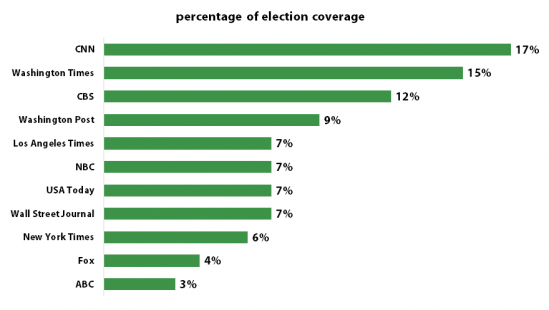
The press is also asked to tie the conventions into a larger narrative about the candidates. And it’s here that questions arise about just how well the news media serve the voters’ interests and needs.
Although conventions are no longer the deliberative events they once were, they remain a key moment in the presidential campaign. The television ratings are smaller than in the era when Americans’ viewing choices were limited to the three broadcast networks, but they are large by today’s standards. More than 25 million Americans watched the 2016 conventions on the average night, and the presidential nominees’ lengthy acceptance speeches drew more than 30 million viewers.[22] In an era of ten-second sound bites and thirty-second political ads, it’s hard to argue that the conventions somehow fail to serve the voters’ interests and needs.
There is also reason to embrace much of the convention news coverage. The daily news audience is easily double that of the convention viewing audience and, for many Americans, the convention that they know is the one they hear about through news outlets. At its best, as with other key moments, the press performs the invaluable task of highlighting the convention’s key points, pulling them out from the cascade of convention speeches.
But the press’s role goes beyond describing major developments within the halls of the conventions. The press is also asked to tie the conventions into a larger narrative about the candidates. And it’s here that questions arise about just how well the news media serve the voters’ interests and needs.
Election news would be limp without attention to the horse race. The election’s bottom line—who will win in November?—is of undeniable interest. What’s open to debate is the relative importance of the horse race in the middle of the summer. During the convention period, horse race coverage thoroughly dominated coverage of national policy and leadership, even though the conventions are a time when questions of policy and leadership come to the forefront of the campaign.
Trump’s issues and leadership did get a substantial dose of news attention. Nevertheless, there can be no mistaking the reason. His policy and leadership pronouncements made for good stories. Had they been more conventional, they would have received no more news attention than Clinton’s did. No policy issue of her campaign accounted for more than 1 percent of her news coverage and, added together, her policy stands comprised less than a twentieth of her coverage. As for her tenure as First Lady, U.S. senator, and secretary of state, she could just as well as have spent those years baking cookies. Retrospective news stories on what her lengthy public service might suggest about a Clinton presidency were so rare as to barely register in our content analysis of convention coverage.
What was easy to count were the news references to Clinton’s emails. They were a defining feature of her news coverage. Remarkably, a key dimension of the email issue was seldom addressed: What should we make of the emails? How important, exactly, are they in the larger question of choosing a president? And just how large a transgression are they?
Judging from their news stories, journalists rate the emails as being highly significant, and very serious. They are played heavily, and with a damning tone. When 90 percent or more of the coverage of a subject is negative, the verdict is in. In today’s hypercompetitive media environment, journalists find it difficult to resist controversies—“medialities,” as Michael Robinson labeled them.[23] In 2011, Donald Trump, while toying with a presidential bid, questioned whether President Obama was a native-born American.[24] Trump’s statement was seized upon by cable outlets and stayed on their newscasts for days. Veteran CNN correspondent Candy Crowley interviewed Trump, justifying it by saying: “There comes a point where you can’t ignore something, not because it’s entertaining. … The question was, ‘Is he driving the conversation?’ And he was.”[25] In truth, the media were driving the conversation, as they have with Clinton’s emails.
Decades ago, the Hutchins Commission on Freedom of the Press concluded that reporters routinely fail to provide a “comprehensive and intelligent account of the day’s events in the context that gives them some meaning.”[26] Whatever else might be concluded about the email coverage, context has been largely nonexistent. To be sure, there are some stories that told of how the merging of private and official emails by government officials was common practice. There are also some, though fewer, that tried to assess the harm, if any, that resulted from her use of a private server. But they’ve been largely lost in the glare of damaging headlines and sound bites.
False equivalencies abound in today’s election reporting.[27] A scandal is a scandal, judging by the liberal amount of coverage that is bestowed on indiscretions, small or large. Journalists have also struggled in their election reporting to weigh differences between the candidates. Clinton and Trump are judged in polls to be nearly equal in their level of untrustworthiness, so they’re treated alike by reporters on that score. Is there not a dime’s worth of difference between them? It’s a question is barely touched upon in election reporting.
Reporters quoted Trump more often about Clinton’s policies than they quoted her.
Negativity, too, should have its limits. It’s clear that partisan attacks make for a better story than policy proposals. But when the negative news reports about the candidates’ policy positions vastly outnumber the positive ones—82 percent to 18 percent for Trump and Clinton combined—one could conclude that the candidates’ platforms are devoid of worthwhile proposals. Or, one could conclude that journalists aren’t all that interested in the candidates’ issue stands, except when they’re attacked by the opposing side. Reporters quoted Trump more often about Clinton’s policies than they quoted her.
Americans have a number of reasons to be unhappy with their choices this year. Trump and Clinton are flawed candidates, though not equally so. But their image in the mind of the voters is not merely a function of who they are, or are not. Their image also reflects their portrayal in the press. It’s hard to look good—perhaps hard even to look marginally okay—when your candidacy is filtered through the lens of news values. Much of what people talk about when their thoughts turn to public affairs is based on what they have just seen or read in the news. “The power of the press is a primordial one,” Theodore H. White observed. “It determines what people will think and talk about.” [28]
Both Trump and Clinton picked their running mate a few days before the start of their party’s convention. Each pick was a governor, and each was seen as a safe choice.
Vice-presidential nominees normally do not receive a lot of news attention even during the convention period, and Mike Pence and Tim Kaine both fit that pattern (see Figure A1). Pence got 5 percent of the convention-period coverage while Kaine received 3 percent. Pence’s greater coverage was largely a consequence of the sequencing of the two conventions. Pence’s coverage peaked during the first and second weeks of the convention period, which coincided with the announcement of his selection and then his nomination at the Republican convention. Kaine wasn’t featured in the news until the day after the GOP convention ended, when Clinton announced his selection. In the two weeks that followed, which included his nomination at the Democratic convention, Kaine received somewhat more coverage than did Pence.
Figure A1: Amount of Vice-Presidential Nominees’ News Coverage
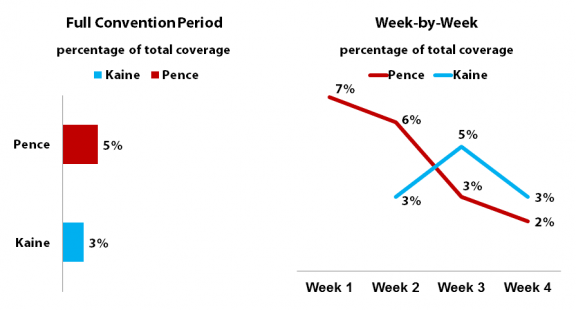
Both Pence and Kaine received more favorable coverage than their running mates (see Figure A2). In fact, both candidates had positive press. Of the news reports about Kaine with a clear tone, positive reports outpaced negative ones by a two-to-one margin. For Pence, the ratio was three-to-two.
Figure A2: Tone of Vice-Presidential Nominees’ News Coverage
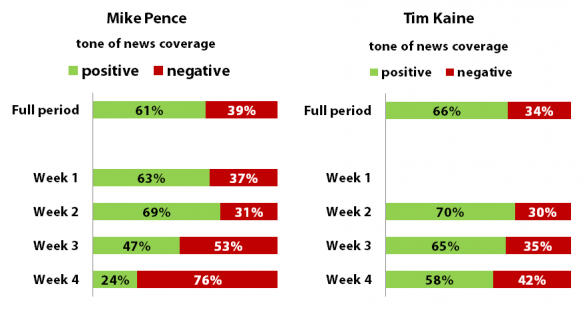
Pence got positive press for his career achievements, the effect of his nomination on party unity, and his leadership qualities and abilities. On the other hand, his issue positions were a source of bad press. His policy positions comprised only 5 percent of his reports, most of which were neutral in tone. Of those that had a clear tone, 83 percent were negative, often in the form of a partisan attack. In her response to Pence’s pick as Trump’s running mate, Clinton targeted his stance on women’s rights. In a Washington Post article, Clinton was quoted as saying that Pence “personally led the fight to defund Planned Parenthood while serving in the House and fought to pass Indiana’s 2016 anti-abortion law, with some of the most outrageous restrictions in the country that threatened women’s privacy and limited their choice.”[29]
Kaine’s personal character was the source of his most positive coverage. His issue stands were reported differently. Although they comprised only 5 percent of his coverage, those with a clear tone were 60 percent negative. As with Pence, the criticisms were voiced by partisan opponents, although, unlike Pence, many of the attacks came from other Democrats, mainly those who preferred Sanders to Clinton. When Kaine spoke at the Democratic convention, for example, some Sanders delegates held up signs and refused to cheer because Kaine had been a strong advocate of free trade. In a news article that noted Kaine’s convention appearance, a Sanders delegate was quoted as saying: “It’s a nightmare scenario. [Clinton’s] given us lip service on the TPP, but once she gets what she wants, will she revert back? That’s one of our greatest fears.”[30]
[1] Paul Weaver, “Is Television News Biased?” The Public Interest 17(1972):69.
[2] Carl Leubsdorf, “The Reporter and the Presidential Campaign,” ANNALS (1976): 6.
[3] Weaver, “Is Television News Biased?” 69.
[4] Daniel Hallin, “Sound Bite News,” Journal of Communication 42 (1922):11.
[5] Ibid; Thomas E. Patterson, Out of Order (New York: Knopf, 1993), p. 75.
[6] “Election Watch: The Markle Report,” Center for Media and Public Affairs, February 28, 1996. http://cmpa.gmu.edu/election-watch-the-markle-report/
[7] Patterson, Out of Order, p. 74.
[8] Michael Robinson and Margaret Sheehan, Over the Wire and On TV (New York: Russell Sage Foundation, 1983), p. 148.
[9] “Election Watch: The Markle Report.”
[10] Thomas E. Patterson, The Vanishing Voter (New York: Knopf, 2002), pp. 70-76.
[11] S. Robert Lichter, “Election Watch: The Markle Report,” http://cmpa.gmu.edu/election-watch-the-markle-report/
[12] This finding has been reported in scores of books and articles, including Patterson, Out of Order.
[13] Media Tenor has several hundred topic categories that are applied to news reports. Figure 5 is based on all categories that received more than 0.5 percent of Trump’s categories.
[14] Michelle Hackman, “Polls Show Trump Falling Behind in Swing States,” The Wall Street Journal, August 4, 2016. http://blogs.wsj.com/washwire/2016/08/04/polls-show-trump-falling-behind-in-swing-states/
[15] Suzanne Gamboa, Victoria DeFrancesco, and Stephen A. Nuno, “Trump Ends Convention as He Started Campaign: Linking Immigrants to Crime,” July 22, 2016. http://www.nbcnews.com/storyline/2016-conventions/trump-ends-convention-he-started-campaign-linking-immigrants-crime-n614551
[16] Robert Kagan, “There is Something Very Wrong with Donald Trump.” The Washington Post, August 1, 2016. https://www.washingtonpost.com/opinions/there-is-something-very-wrong-with-donald-trump/2016/08/01/73809c72-57fe-11e6-831d-0324760ca856_story.html?utm_term=.eeb521fe409a
[17] Rebecca Shabad, “Mitch McConnell Weighs in on Donald Trump’s NATO Remarks,” CBS News, July 21, 2016. http://www.cbsnews.com/news/mitch-mcconnell-weighs-in-on-donald-trumps-nato-remarks/
[18] Steve Turnham, “Donald Trump to Father of Fallen Soldier: ‘I’ve Made a Lot of Sacrifices,’” ABC News, July 30, 2016. http://abcnews.go.com/Politics/donald-trump-father-fallen-soldier-ive-made-lot/story?id=41015051
[19] Eliza Collins, “Clinton Jumps to Big Lead over Trump in New National Polls,” USA Today, August 5, 2016. http://www.usatoday.com/story/news/politics/onpolitics/2016/08/04/clinton-jumps-big-lead-over-trump-new-national-polls/88268536/
[20] Reuters, “RNC 2016: Donald Trump Sharpens Attack on Hillary Clinton in Convention Speech,” July 22, 2016. http://www.amny.com/news/elections/rnc-2016-donald-trump-sharpens-attack-on-hillary-clinton-in-convention-speech-1.12076691
[21] “Poll: Email Investigation Damaged Hillary Clinton’s Image,” CBS News, July 15, 2016. http://www.cbsnews.com/news/poll-email-investigation-damaged-hillary-clintons-image/
[22] Stephen Battaglio, “Democrats Continue to Top Republicans in Convention Ratings, Los Angeles Times, July 28, 2016. http://www.latimes.com/entertainment/envelope/cotown/la-et-ct-democratic-convention-ratings-20160728-snap-story.html
[23] Michael J. Robinson, “The Media in 1980: Was the Message the Message?” in Austin Ranney, ed., The American Elections of 1980 (Washington, D.C.: American Enterprise Institute, 1981): 191.
[24] W. Lance Bennett, “Press-Government Relations in a Changing Media Environment.” in The Oxford Handbook of Political Communication (New York: Oxford University Press, 2014). Published online: http://www.oxfordhandbooks.com/view/10.1093/oxfordhb/9780199793471.001.0001/oxfordhb-9780199793471
[25] Quoted in ibid.
[26] Quoted in Melvin Mencher, “Will the Meaning of Journalism Survive?” Nieman Reports, June 2006. http://niemanreports.org/articles/will-the-meaning-of-journalism-survive/
[27] See, Jonathan Chait, “New York Times Public Editor Liz Spayd Writes Disastrous Defense of False Equivalence,” New York Magazine, September 12, 2016. http://nymag.com/daily/intelligencer/2016/09/times-writes-disastrous-defense-of-false-equivalence.html
[28] Theodore H. White, The Making of the President 1972 (New Yor: Bantam, 1973), p. 327.
[29] Ariana Eunjung, “Mike Pence Has Made No Secret about His Views on Abortion. Will this Help or Hurt Trump?” The Washington Post, July 15, 2016. https://www.washingtonpost.com/news/to-your-health/wp/2016/07/15/mike-pence-has-made-no-secret-about-his-views-on-abortion-will-this-help-or-hurt-trump/
[30] Haley Sweetland Edwards “Division on Trade Disrupts Democratic Convention,” Time, July 28, 2016. http://time.com/4427424/dnc-trade-tpp-democratic-convention-hillary-clinton/

Explainers, Podcasts, Videos
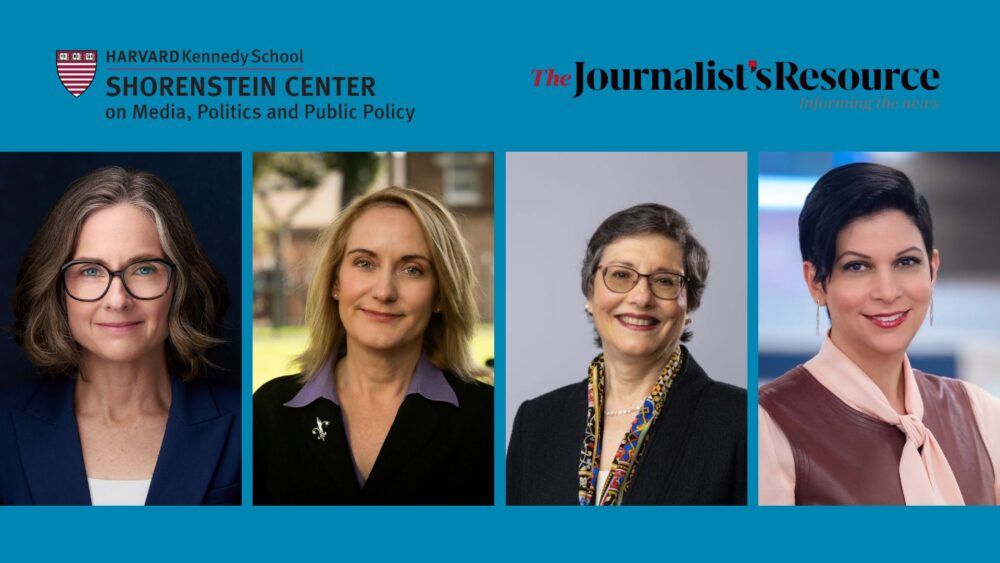
Videos

Reports & Papers